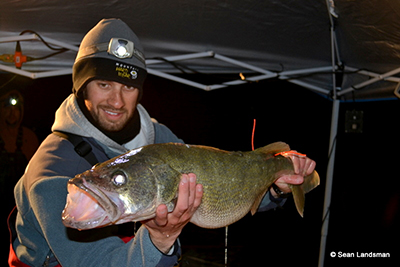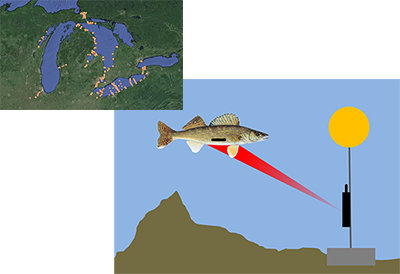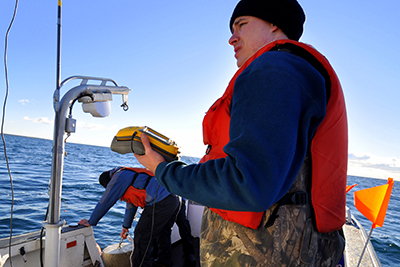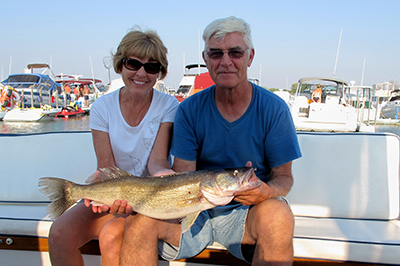Faithful Fish: Walleye Show High Spawning Site Fidelity in the Great Lakes
This article is based on a recent paper, Spawning site fidelity and apparent annual survival of walleye (Sander vitreus) differ between a Lake Huron and Lake Erie tributary, in Ecology of Freshwater Fish, The paper is available at: https://doi.org/10.1111/eff.12350.

Credit: Sean Landsman, Carleton University
Imagine you are a fish in a Great Lake preparing to spawn. Where would you go? How would you find a mate? If it's your first time spawning in one of these vast lakes, then you might have to pick a spot and hope for the best, or use some other clue to find a spawning location. But if it's your second time and you already know the first place you spawned was a good one, wouldn't you go back to the same place again? New research funded by the Great Lakes Fishery Commission suggests walleye do just that.
For fish, the habit of returning to the same place year-after-year to spawn is called "spawning site fidelity". Spawning site fidelity can be a consequence of learning by fish, or the result of imprinting while young on natal, or birth, locations (called natal homing). Either way, returning to previous spawning areas is advantageous because fish experience less risk when they spawn; that is, a fish can safely assume if mates were present last year, mates will likely be present again in future years. Likewise, habitat suitable for spawning one year is likely to be suitable in subsequent years.

Credit: Sean Landsman, Carleton University
In the past, scientists studying walleye spawning site fidelity in the Great Lakes had to infer fish behavior after-the-fact based on data obtained from marking a fish with an external tag, such as a jaw tags, and recapturing the fish months or years later. Although this method was useful for telling scientists when a fish was present at a particular location, the method only provided a snapshot of where the fish had traveled. Scientists did not know when the fish arrived, how long the fish stayed, how many times the fish visited, and where the fish went in between visits to the specific locale.
A research team led by Dr. Todd Hayden and collaborators at Michigan State University, the U.S. Geological Survey, Michigan Department of Natural Resources, Carleton University, and the Great Lakes Fishery Commission, began tagging walleye with acoustic telemetry tags to fill in those knowledge gaps. Acoustic telemetry allows scientists to track movements of fish in great detail. If older methods like jaw tags provide data akin to photographs, then acoustic telemetry is like a video, providing a detailed history of movements and behaviors through space and time.

Credit Upper: Chris Holbrook, USGS, and Andrea Miehls, GLFC.
Credit Lower: Great Lakes Acoustic Telemetry Observation System.
Acoustic telemetry works like electronic toll collection systems such as I-Pass or E-ZPass: an internally-tagged fish swims through a network of receivers, like a car passing through a toll-booth. The acoustic tag inside the fish continuously "pings" a unique ID number, which receivers—essentially underwater computers—detect and record, along with the date and time for every tagged fish that swims nearby. By stationing receivers in a wide variety of locations (known migration corridors, presumed spawning locations, and other places where scientists expect fish to be), and later retrieving the receivers to download the data collected, scientists can determine the exact movements of a particular fish.

Credit: Todd Hayden, MSU.
For the walleye study, Dr. Hayden and collaborators wanted to confirm previous observations of walleye spawning site fidelity with greater certainty than older tagging methods allowed. Additionally, the research team investigated whether spawning site fidelity differed between walleye aggregations in two spawning areas: the Tittabawassee River (a tributary to Saginaw Bay in Lake Huron) and the Maumee River (a tributary to the western basin of Lake Erie). The researchers chose these sites because of the large number of walleye spawning at each site: the Tittabawassee River supports the largest known spawning aggregation of walleye in Lake Huron, estimated at almost 200,000 fish, and the Maumee River supports a walleye population of approximately 600,000 fish.
During 2011 and 2012, the research team implanted acoustic telemetry tags in almost 500 walleye, then followed their movements through the 2014 spawning season. More than 300 receivers were used to track the fish, including multiple receivers in both rivers, near the river mouths, across key migration corridors, and along the shorelines of Lake Huron and Lake Erie. In total, 311,180 detections from tagged walleye were recorded on the receiver network. When the research team compiled the detections to create movement paths for the walleye, the results were remarkable.
The movements of four walleye from the Tittabawassee River and three walleye from the Maumee River during 2011-2014. Receiver locations are denoted by small, orange, circles; Tittabawassee River walleye are large, red, moving circles; Maumee River walleye are large, blue, moving circles; and the walleye release points are green triangles. Detections on receivers are indicated by light pink (Tittabawassee River) and light blue (Maumee River) shades of the walleye circles, whereas interpolated locations are indicated by dark red (Tittabawassee River) and dark blue (Maumee River) shades.
Walleye in the Tittabawassee River showed strong spawning site fidelity, with a 95% return rate to the river. Walleye in Lake Erie showed less spawning site fidelity, although 70% were still faithful to the Maumee River.
"Greater fidelity of walleye tagged in the Tittabawassee River than in the Maumee may be due to the close proximity of the Maumee River to other spawning sites in Lake Erie," Dr. Hayden explained. "Multiple spawning sites in close proximity to the Maumee River may increase the likelihood that some individuals will stray, choosing a different spawning location from previous years."

Credit: Andrea Miehls, GLFC.
In contrast, the Tittabawassee River supports the largest known spawning aggregation in all of Lake Huron. Walleye that previously spawned in the Tittabawassee River may return to the river in subsequent years because the probability of encountering other spawning aggregations in Saginaw Bay or Lake Huron is low. Alternatively, high spawning site fidelity for these fish may be due to natal homing, although the potential for homing has not been studied in Lake Huron walleye.
Another notable outcome of this work was documenting lengthy migrations of walleye in Lake Huron. Many walleye undertook annual migrations of almost 500 miles round-trip, moving from spawning areas in the Tittabawassee River to feeding grounds in northern Lake Huron. Although these long migrations had been suggested previously based on jaw tag studies, the research team was able to confirm in detail the timing and popular migration pathways of walleye migration in Lake Huron.
Understanding spawning site fidelity has important implications for management of walleye in the Great Lakes. When spawning site fidelity is low or moderate for a fish species in a given lake, those fish can be managed as a single population—essentially, all of the fish in the lake can be considered to be part of a single group. However, as spawning site fidelity increases, management actions need to increasingly focus on individual populations within lakes. In other words, fish spawning in different locations should be considered different groups, and may need to be managed using different strategies tailored to each group. A good example of this approach is Pacific salmon management on the west coast of North America. Salmon have high spawning site fidelity to individual rivers which flow into the Pacific Ocean. Consequently, in some areas, salmon in different rivers are managed as separate populations, with river-specific harvest rates, seasons, and gear types allowed.
"Based on these findings, the current paradigm of managing the western Lake Erie walleye stock as a single population may be justified given that approximately 30% of walleye we tagged did not return to the Maumee River but likely spawned at different locations in Lake Erie or did not spawn every year," explained Dr. Hayden. "Conversely, due to the high spawning site fidelity of walleye to the Tittabawassee River, managers may need to consider treating that river as its own unique population to conserve adaptations of those walleye to the area."

Credit: Dianne Miehls.
"Walleye support the second largest fishery in the Great Lakes, and the single most valuable fishery in Lake Erie," said Commissioner Jim McKane, chair of the Great Lakes Fishery Commission. "Studies which inform management practices, such as the one conducted by Dr. Hayden and colleagues, are essential to maintaining productive fisheries and protecting our valuable natural resources in the Great Lakes."
Read more Pulse on Science: Project Spotlights
- New Study Concludes Invasive Sea Lampreys Can Be Controlled by the Release of Sterilized Males
- Happy 75th anniversary to Hammond Bay Biological Station!
- Great Lakes Habitat Restoration: Partnering to Promote Fish Production
- Sea Lamprey Control Spreads the Distance
- Making the Best of a Bad Situation: Great Lakes Sea Lampreys Reveal the Origins of Vertebrate Traits
- Studying the Fish of Buffalo Reef, Traverse Bay, Lake Superior
- Doing Science is Essential...Communicating Science is Just as Critical (and maybe more FUN!)
- Faithful Fish: Walleye Show High Spawning Site Fidelity in the Great Lakes
- Finding the Sea Lamprey's Kryptonite
- Good Things Come in...Polymer Packages?
- Rambunctious Reproduction Overheard Among Great Lakes' Lake Trout
- Clearer Water Means Less Fish: Understanding How Lower Trophic Level Changes Impact Lake Huron's Fisheries

